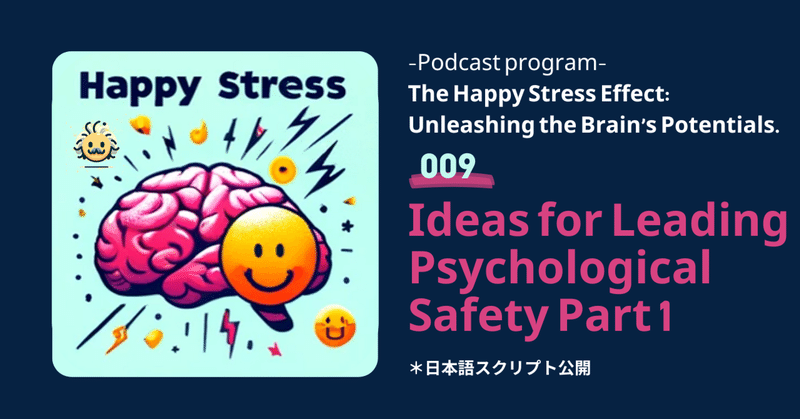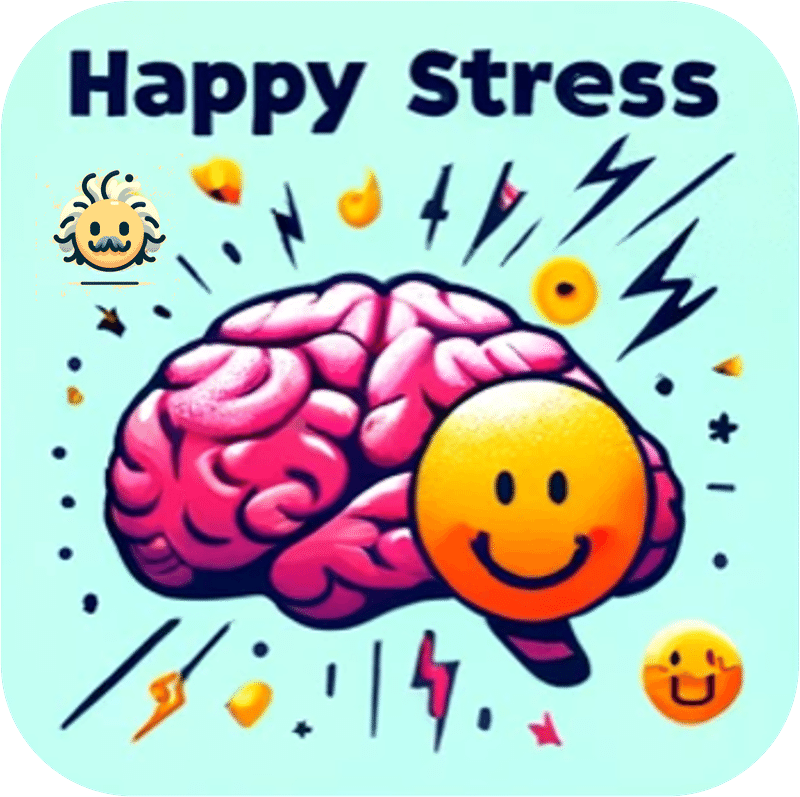
【The Happy Stress Effect 009】 Ideas for Leading Psychological Safety Part 1
毎週月曜日の午後に更新!
海外の方々に向けて、英語でHAPPY STRESSを紐解くPodcast番組 『The Happy Stress Effect: Unleashing the Brain’s Potentials』
今週も、第9回エピソードをSpotifyにて配信開始いたしました!
今週のテーマは「心理的安全性を導くためのポイント part 1」です。
本記事では、日本語訳と英語のスクリプトをお届けいたしますので、あわせてお楽しみいただけましたら幸いです✨
009-Ideas for Leading Psychological Safety Part 1 (2024/03/11)
Script Translation/日本語
*以下はChatGPTを使用して日本語に翻訳しています。かなり精度は高まってきていますが、まだまだ完全ではございません。そんなGPTさんの成長も楽しみながらお読みいただけますと幸いです。
皆さん、こんにちは。『The Happy Stress Effect: Unleashing the Brain’s Potentials』の世界にようこそ。私は進行のアルバートです。今日は、私たちの生活であまりにも馴染み深いトピック「ストレス」について掘り下げていきます。でも、ちょっといいですか?これは複雑な科学用語を深く掘り下げるということではありません。ストレスを共感できるものにし、理解しやすく、何よりも日常生活に適用できるようにするためのものです。
実際、ストレスは単なる敵ではなく、私たちを守り、強化し、成長させるために不可欠な要素でもあるのです。この番組では、私たちの脳と体が基本的なレベルでストレスとどのように相互作用しているかを探っていきます。なぜストレスが私たちの生物学と人間性の自然な一部なのか、そしてこれを知ることが私たちがそれをどのように捉えるかを変えることができるのかを明らかにしていきます。でもそこで終わりません。
科学と技術の進歩により、私たちは今、ストレス反応を操る細胞や分子にのぞき込むことができます。私たちは、これらの魅力的な洞察のいくつかを「Happy Stress」(青砥瑞人 著)という書籍を使って、理解しやすい形で明らかにしていきます。
前回のエピソードでは、心理的安全性と慢性的なストレス管理の重要性について深く掘り下げ、これらの要因が私たちのメンタルウェルビーイングとパフォーマンスにどれほど影響を与えるかを探求しました。心理的安全性の欠如や慢性的なストレスが放置される環境では、個人は絶え間ない警戒状態にあり、創造性、生産性、そして総合的な満足度が低下します。これらのストレス反応のメカニズムと心理的安全性の重要な役割を理解することで、成長、革新、そして回復力が栄える環境を育む力を得ることができます。今日も、心理的安全性を育む戦略とストレスを効果的に管理する方法を探求していきましょう。これにより、個人的にも職業的にも健康で充実した生活を確保できます。
心理的安全性の重要性を理解することで、ストレスを効果的に対処する上で重要な立場に至ったと考えています。今日は、心に留めておくべき4つの要点を指摘したいと思いますが、まずは最初の2つを紹介させていただきます。
最初の要点は、ストレッサー(ストレスの原因)を気づくことが重要です。
ダークストレスに対処するためには、大まかに2つのアプローチがあります。一つはダークストレスの原因にどう対処するか、もう一つはそれをダークストレスに変えないための予防的なアプローチです。後者は特に重要であり、なぜなら私たちが経験する多くのダークストレスは、自分たちの脳によって培われているからです。
これは、最初は小さなストレッサーでも、気づいたらそれが大きなものに膨れ上がってしまうという状況になります。小さなストレス反応に早めに対処できれば、それがダークストレスに発展するのを防ぎ、苦しみの可能性を減らすことができます。したがって、まず最初に、小さなストレッサーに対処するいくつかの方法を考えてみましょう。
昔から言われているように、何らかの形でストレスが蓄積していると感じることができれば、そのストレスの間接的な原因、つまりストレッサーが何であるかを観察し、紙に書き留めることが効果的です。
特に、はっきりとしたストレッサーが分からず、漠然としたストレスを感じる場合には、この方法が効果的です。なぜなら、脳は曖昧さや不確実性を嫌うため、さまざまな源泉からストレス反応を引き起こす可能性があります。
脳のストレス反応のメカニズムはある程度固定されていますが、これらの反応を引き起こすストレッサーは非常に多様です。各ストレッサーがそれぞれ重要ではないように見えるかもしれませんが、これらが組み合わさることで体内で慢性的または過剰なストレス反応を引き起こす可能性があります。
「今感じているストレスはどこから来ているのだろうか?」と、自分に問いかけてみてください。体と心の声に耳を傾け、それを書き留めることで、あなたが何に悩まされているのかがわかるかもしれません。その時点で、もう少し安心感を感じ始めるかもしれません。
それはなぜでしょうか?これらの小さなストレッサーは、単体では重要なものとして認識されないかもしれません。しかし、仕事での小さなミス、周りの騒音、誰かからの軽い発言、遅いWi-Fi、ちょっとしたタイムプレッシャー、厳しい上司からの圧力、やりたいことができないことなど、これらのそれぞれのストレスは単独では重要ではないかもしれませんが、集まるとある瞬間に言い表せないストレスの感覚につながります。
これらの小さなストレッサーを認識し、それらを心の中で重要ではないストレスとラベリングすることで、それに対処する明確な方法が見つかるかもしれません。「ああ、これが私がすべきことだ」と考えることができます。あるいは、「これにストレスを感じる意味はない」「無駄だ」と考え、意識的にストレス反応を解放し、それを軽減させることができます。
小さなストレス反応が積み重なる場合、それらを認識して放つこと、「こんにちは」と言ってから「さようなら」を告げることで、問題を解決することがあります。そのため、経験的に言われているように、それらを書き留めて落ち着かせることは、脳内の漠然としたストレスの原因を明確にし、ダークストレスの発展を防ぐという点で実際に効果的です。
2つ目のポイントは、ストレッサーを手放し、積極的に脳を活用することに焦点を当てることです。
紙にストレッサーを書き留めることは一つの方法であり、時折効果的であるかもしれませんが、これが唯一の解決策ではありません。他にもいくつかの例を見てみましょう。
ストレッサーを認識すると、多くの人は問題解決モードに入りがちです。簡単に解決できる問題は解決しても良いですが、解決策を探すことがストレス反応を軽減する唯一の方法ではありません。
情報が脳と体を通過しない限り、ストレス反応は引き起こされません。そして、ストレス反応の中には、不快な経験を思い出すことやそれから不快な出来事を予測することなど、記憶に基づくものがあります。したがって、脳が不快な経験の記憶を保持していなければ、そのようなストレス反応はまず発生しません。
したがって、小さなストレッサーに関しては、そのストレッサーに焦点を当てて解決しようとするよりも、それを放つこと、つまり脳の記憶に留めないようにすることが効果的です。言い換えれば、ストレスの源に焦点を当てて解決しようとすることが、結果的にそのストレスの源を脳で培うことにつながる可能性があります。
本当に問題解決が必要な場合、焦点を問題に当てることは確かに重要ですが、すべてのストレッサーを解決しようとする価値はありません。私たちは限られた時間しか持っておらず、不必要なストレッサーに時間を費やす余裕はありません。不要なストレッサーを認識し、放つことは、ストレスに対処する上で非常に重要なスキルです。
この目的のために、効果的な方法の一つは何かアクティブなことをすることです。小さなストレッサーでも、それを思い出す回数が増えるほど、より強いストレス反応につながることがあります。一部の人はそれを他の記憶と結びつけ、不要な詳細を追加し、追想するうちにそれをダークストレスに進化させることがあります。もし小さなストレッサーとして認識したなら、それが脳に留まるのを防ぐために、脳に別のことをさせることが、小さなストレッサーがダークストレスに成長するのを防ぐ方法です。
その鍵は、何かアクティブなことを行うことです。記憶を思い出すことは、脳の記憶検索機能をアクティブに使用する行為です。脳は一度に多くのアクティブな機能を簡単には実行できません。言い換えれば、他のことを受動的に行うのではなく、積極的に脳を使用する必要があります。
例えば、テレビを見たり、映画を見たり、音楽を聴いたりして気晴らししようとすることは、強い受動性の要素を含んでいます。もし好きな番組や映画を本当に集中して観ることができるなら、またはそれが本当に小さなストレッサーである場合、このように注意を切り替えることは効果的かもしれません。しかし、考えずにただ見たり聴いたりしている場合、注意が無意識にストレッサーに戻ってしまい、気晴らしが効果的でなくなる可能性があります。
では、脳を積極的に使用するとはどういうことでしょうか?もちろん、意識的に他のことを考えることを指すかもしれませんが、ストレスの源が記憶の呼び起こしやネガティブな考えである場合、それはやや難しいかもしれません。したがって、身体的な行動を取り入れることが推奨されています。
運動はその一例です。ただし、気軽に散歩やジョギングに行くだけでは、その活動に完全に集中するのに十分でないかもしれません。あまりにも馴染みのある運動や強度が低すぎる運動は、脳の容量を十分に活用しない可能性があり、不要な思考が忍び込む余地を残すかもしれません。例えば、速いペースで走っていると、ネガティブな考えに真剣に取り組む余裕がないかもしれませんが、ゆっくりとしたペースでは同じような気晴らしを提供できないかもしれません。
運動はストレス軽減のためにおすすめされていますが、その強度に注意することが重要です。複雑な運動もおすすめです。例えばヨガは、通常は行わないような動きをする際に体にかなりの注意を払う必要があります。したがって、複雑な要素を含む運動に取り組むか、モノトーンな運動をより集中を必要とするように組み合わせることで、不要な心理的なストレスから解放される時間を作るのに役立つでしょう。
運動だけでなく、絵を描く、文章を書く、音楽を作る、模型を作る、LEGOで遊ぶ、そして「これをやるべきか、それともあれを試してみたらどうだろう?」と考えることも、全て脳を積極的に使う活動です。素晴らしいものを生み出すというプレッシャーを感じずに創造的な時間を設けることも、生活を豊かにし、心を落ち着かせる方法の一つとなります。
ポイントは、ストレス反応は、ストレス反応のために設計された脳と体の配線を使用しているからです。他の配線を十分に使用すれば、ストレス反応を発揮するのが難しくなります。小さな重要でないストレッサーを認識し、それらが脳に留まらないように他の積極的な脳の使用に焦点を当てることは、意識的なアプローチとして考えるべきです。
本日の「The Happy Stress Effect: Unleashing the Brain’s Potentials」を結ぶにあたり、私たちは心理的安全性とストレスマネジメントの微妙な領域を巡りました。ストレッサーの認識と積極的な参加の重要性を明らかにしました。今日の議論の中心には、意識と積極的な参加が、心理的な環境を構築する上での変革的な力があることが浮かび上がっています。相互作用と個人の課題に対して注意深いアプローチを育むことで、私たちはストレスを大幅に軽減し、総合的なウェルビーイングを向上させることができます。次のエピソードでもいくつかのポイントを続けて探求しますので、お楽しみに!
参加いただきありがとうございました。これから、さらなる力を引き出すトピックを一緒に探求できることを楽しみにしています。次回まで、私、アルバートが「HAPPY STRESS」と喜びに満ちた瞬間であふれる一日をお祈りしています。

Original Script/英語
Welcome, everyone, to "The Happy Stress Effect: Unleashing the Brain’s Potentials". I'm your host Albert, and today, we're delving into a topic that's all too familiar in our lives - stress. But hold on, this isn't going to be a deep dive into complex scientific jargon. We're here to make it relatable, understandable, and most importantly, applicable to our daily lives.
You see, stress isn't just an adversary; it's also a vital component that protects, strengthens, and even fosters growth within us. In this program, we're exploring how our brains and bodies interact with stress on a fundamental level. We'll uncover why stress is a natural part of our biology and humanity, and how knowing this can reshape the way we perceive it. But it doesn't stop there.
With advancements in science and technology, we're now able to peek into the very cells and molecules that orchestrate our stress responses. We'll be demystifying some of these fascinating insights using this book called "Happy Stress" by Mizuto Aoto in a way that's easy to grasp.
In our last episode, we delved deep into the critical importance of psychological safety and managing chronic stress, exploring how these factors profoundly influence our mental well-being and performance. We uncovered that in environments lacking psychological safety, where chronic stress festers unchecked, individuals find themselves in a constant state of alert, leading to diminished creativity, productivity, and overall satisfaction. By understanding the mechanisms behind these stress responses and the pivotal role of psychological safety, we empower ourselves to foster environments where growth, innovation, and resilience can thrive. Join us today as we continue to explore strategies to cultivate psychological safety and effectively manage stress, ensuring a healthier, more fulfilling life both personally and professionally.
By understanding the significance of psychological safety, I believe we've come to see an important stance in dealing with stress effectively. I would like to point out four key points to keep in mind but let me introduce the first 2 for today.
The first key point is to be able to notice the stressors.
There are broadly two approaches to dealing with dark stress: one is how to deal with the causes of dark stress, and the other is a preventive approach to not turning it into dark stress. The latter is particularly important because much of the dark stress we experience is cultivated by our own brains.
This can be likened to a minor stressor that, before we know it, has ballooned into something much bigger. If we can deal with minor stress responses early on, we can prevent them from becoming dark stress, reducing the possibility of suffering. Therefore, let's first consider some ways to deal with minor stressors.
As has long been said, if you can feel (notice) that you're somehow accumulating stress, it is effective to observe the indirect causes of that stress—what the stressors might be—and write them down on paper.
Especially when you're not aware of a clear stressor and just feel vaguely stressed, this method can be effective because the brain dislikes ambiguity and uncertainty. The brain can lead to stress responses from various sources.
The brain can lead to stress responses from various sources.
While the mechanism of stress response in the brain is somewhat fixed, the stressors that trigger these responses vary widely. Even if each stressor might not seem significant, they can collectively lead to chronic or excessive stress responses within the body.
Ask yourself, "Where is the stress I'm feeling right now coming from?" By listening to the voice of your body and mind and writing it down, you're likely to realize what's bothering you. By then, you may already start feeling more at ease.
Why is that? Each of these minor stressors, in isolation, might not be recognized as significant. However, they could be small mistakes at work, noise around you, slight remarks from someone, slow wifi, a bit of time pressure, pressure from a strict boss, or not being able to do something you want to do. Each of these stresses might not be significant on their own, but collectively they lead to an indescribable feeling of stress at a certain moment.
By recognizing these minor stressors and labeling them as insignificant stresses in your mind, you might find clear ways to deal with them, thinking, "Ah, this is what I should do." Or you might think, "There's no point in stressing about this," or "It's a waste," and consciously let go of the stress response, thereby reducing it.
In the case of accumulating minor stress responses, acknowledging and letting them go—saying "hello" and then "goodbye"—often resolves the issue. Therefore, writing them down to calm down, as has been experientially said, is indeed effective as it clarifies the vague stressors in the brain, preventing the growth of dark stress.
The second point is to let go of the stressors and focus on using the brain actively.
Writing stressors on paper is just one method and can be effective at times, but it's not the only solution. Let's look at some other examples.
When people recognize a stressor, many tend to go into problem-solving mode. It's fine to solve problems that are easily resolvable, but searching for solutions isn't the only way to alleviate stress responses.
Stress responses won't be triggered if information doesn't flow through the brain and body. And among the stress responses, some are derived from memories, such as recalling an unpleasant experience or anticipating something unpleasant from it. Therefore, if the brain doesn't retain memories of unpleasant experiences, such stress responses won't be triggered in the first place.
So, for minor stressors, rather than focusing on the stressor and trying to solve it, it's effective to let it go, meaning not to let it settle in the brain's memory. In other words, focusing on the source of stress to solve it might end up cultivating that source of stress in the brain.
In cases where genuine problem-solving is needed, focus may indeed need to be on the issue, but it's not worth trying to solve every stressor. We have limited time, and there's no time to deal with unnecessary stressors. Recognizing and letting go of unnecessary stressors is a very important skill in dealing with stress.
For this purpose, one effective method is to do something active. Even minor stressors can lead to a stronger stress response the more you recall them. Some people might connect it to other memories, add unnecessary details, and evolve it into dark stress as they reminisce. If you've recognized it as a minor stressor, to prevent it from settling in the brain, get the brain to do something else, which is a way to prevent minor stressors from growing into dark stress.
The key is to do something active. Recalling a memory is an active use of the brain's memory search function. The brain can't easily perform many active functions at once. In other words, it's necessary to use the brain actively rather than passively doing other things.
For instance, just trying to distract yourself by casually watching TV, movies, or listening to music involves a strong element of passivity. If you're watching a favorite show or movie and can really concentrate on it, or if it's truly a minor stressor, then shifting your focus in this way can be effective. However, if you're just watching or listening without much thought, your attention might inadvertently drift back to the stressor, rendering the distraction ineffective.
So, what does it mean to use the brain actively? Of course, it could mean consciously thinking about something else, but if the source of stress is memory retrieval or negative thinking, that might be somewhat challenging. Therefore, it's recommended to involve physical action.
Exercise is a prime example. However, simply going for a casual walk or jog might not be enough to fully focus on the activity. Exercises that are too familiar or too low in intensity might not use enough of your brain's capacity, allowing room for unwanted thoughts to creep in. For example, if you're running at a brisk pace, you might not have enough mental resources left to seriously engage with negative thoughts, but a leisurely pace might not provide the same distraction.
Exercise is recommended for its stress-reducing benefits, but it's good to be mindful of the intensity. Complex exercises are also recommended. Yoga, for example, requires considerable attention to your body as you move in ways you might not typically do. So, engaging in exercise with some complexity, or combining monotonous exercises in a way that requires more focus, can help carve out time free from unnecessary psychological stress.
But it's not just exercise; drawing, writing, making music, building models, playing with LEGO, and thinking "Should I do it this way or that? What if I try this?" are all active uses of the brain. Setting aside creative time without the pressure of producing something great can also be a way to enrich your life and find calm.
The point is, stress responses occur because we use the wiring in the brain and body designed for stress responses. If we sufficiently use other wiring, it's harder to exhibit stress responses. Recognizing minor and insignificant stressors and not letting them settle in the brain by focusing on other active uses of the brain might be a conscious approach to consider.
As we conclude today's enlightening journey on The Happy Stress Effect: Unleashing the Brain’s Potentials, we've navigated the nuanced landscape of psychological safety and stress management. We've uncovered the pivotal role of recognizing stressors and about embracing proactive engagement. The essence of our discussion highlights the transformative power of awareness and active participation in crafting our psychological environment. By cultivating a mindful approach to our interactions and personal challenges, we can significantly mitigate stress and enhance our overall well-being. We will continue on with a couple of more points in the next episode so stay tuned with us!
Thank you for joining us, and we look forward to exploring more empowering topics with you in future episodes. Until next time, I'm Albert, wishing you a day filled with "HAPPY STRESS" and joyful moments.
